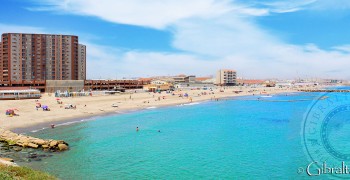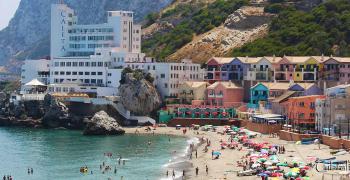If hiking is something you love, your visit to Gibraltar can offer you some amazing options. One of such hikes, that is not without risks nor for the faint hearted is the Mediterranean Steps. Though not for those who are out of shape or a fear of heights, the Mediterranean steps offer you the chance to combine a good long hike, with incredible views along with a bit of thrill thrown in.
Nice shot of the Mediterranean Steps in Gibraltar showing the very nicely installed side ropes and poles for safety.
Quite some years back, the Government of Gibraltar posted the steps as unfit, and in essence said they should not be used. Since that time, thanks to financing from the Parasol Foundation (formally the Bonita Trust) and the management of the Government of Gibraltar, major refurbishing of the Mediterranean steps has taken place. The summer of 2007 saw a serious makeover where stretches of the trail had been long neglected and damaged, and since then have been additionally restored with new sturdy rope handrails in sections that are particularly steep and dangerous.
The history of the Mediterranean Steps is as unique as the area itself, and as much involved with the defences of the area as many of the other attractions of Gibraltar. They were created back in the 18th century by the British military as part of a system of communication for soldiers to allow access to the various defence posts at the southern end of the Rock. These included Levant, Martin’s, O’Hara’s and Lord Airey’s Batteries, as well as several other gun emplacements and ancillary buildings dating back to World War II.
The walk basically starts at Jews’ Gate at the entrance to the Upper Rock Nature Reserve opposite the Pillars of Hercules. Setting off at roughly 180 metres above sea level, the hike up the Mediterranean Steps will take you on an incredibly scenic journey running mainly along the eastern side of the Rock, ending up at O’Hara’s and Lord Airey’s Batteries about 421 metres above sea level, right at its highest summit.
Although primarily made up of steep cliffs and low Mediterranean scrub, the 1,800 metre trek actually sets out (if walking UP the steps from Jews Gate and not down) heading south through some quite dense but very beautiful bushy vegetation. You almost feel like you are walking through a garden tunnel at times. Then almost very suddenly the thick vegetation opens out to reveal a breathtaking view of North Africa 14 miles or so across the Strait.
Keep your eyes open as you walk and you may be lucky enough to catch a glimpse of the very rare Barbary Partridge running across your path. If not, don’t be dismayed, enjoy taking in the multiple types of wildflowers that will be blooming, and washing the landscape with their amazing colours.
Nice portrait shot of a Barbary Partridge seen on Martin's path along the Mediterranean Steps walk in Gibraltar.
The limestone of Gibraltar, surrounded by the sandstone means that the flora of Gibraltar has influences from other areas, such as North Africa, but is also home to some very unique and unusual plant life, such as may grow nowhere else in Europe, or in some cases even the world. More than 500 different species of plants are hosted by just 2 and a half square miles of Gibraltar, which is an enormous ecosystem for such a small area. Native to the Rock of Gibraltar are plants such as the Gibraltar Candytuft, Gibraltar Thyme, Gibraltar Sea Lavender and the very rare and critically endangered Gibraltar Campion.
The pathway (Martin’s Path) gradually bends northward clinging to the edge of the rocky cliffs. The views up and down from this point are absolutely fabulous. You will also notice a definite increase of bird life from this point on. Yellow-legged Seagulls will be swooping all over the show, and if you are fortunate enough, you may get to see a pair of Peregrine Falcons that nest here every year. Depending on the time of the year, the Eurasian Black Vulture, the Short-toed Eagle, the European Shag that often breed on the cliffs of Gibraltar, the Golden Eagle, the Griffon Vulture, the Blue Rock Thrush, and the Egyptian Vulture are to name but a very few of the incredible species that can be witnessed on the Rock.
Martin’s path in reality actually continues on to Martin’s Cave. Unfortunately though, due to past vandalism, the entrance to the cave is now closed off and NOT open to public. This however is where the rare Schreiber’s bat breed, spending most of their day snoozing in the very back dark recesses of the cave. The area surrounding Martin’s Cave is also where the Gibraltar Sea Lavender grows, the only place on the Upper Rock Nature Reserve that this plant can be found.
Continued accent of the steps will lead you to the Goat’s Hair Twin Caves found directly on the left of the pathway. The two caves actually give evidence of prehistoric human habitation. During the 1970’s a number of artifacts were excavated from one of the caves indicating that prehistoric man had once inhabited them. This is also a good point along the journey to take a short breather and a bite of that snack you hopefully brought along with you. The view from here as you sit and refuel is absolutely breathtaking.
Interesting Fact
It’s amazing to think that both Martin’s Cave and the Goat’s Hair Twin Caves were all at some point in history, lying at sea level, now and incredible 210 metres below!
Continuing the climb to the top of the first flight of steps, you will come across a building built by the military during World War II. You then continue through a small tunnel, after which further World War II fortifications are found. This is where you will reach a viewing platform that will give you an amazing view of the eastern side of the Rock. From this point on the path begins to steepen, and you can actually see the stairway ahead zigzagging its way up the side of the cliff face. After a couple more World War II fortifications you will find yourself at the base of the cliff.
Partial view of one of the WWII buildings as seen through the tunnel along the Mediterranean Steps in Gibraltar.
From here the path puts you to a final test of endurance, ascending the summit up a dizzying flight of lime cut stairs. This is where if you are not a fan for heights, its best to keep looking up and not back down again! After a relatively strenuous effort you will reach the summit. And what an amazing feeling of achievement it is. The incredible views that await you across the Bay of Gibraltar and the Strait are beyond words. Here is where the Mediterranean Steps walk ends. Very close toward the south, you will see Lord Airey’s and O’Hara’s Batteries – having come this far they are definitely worth the visit.
It’s up you at this point whether you want to retrace your path back down the steps, walk down to St Michael’s Cave etc, or walk to the Cable Car’s Top Station and catch the cable car back down. Whatever you decide, remember when planning on walking the Mediterranean steps to allow yourself at least two hours. Take plenty of water to keep yourself hydrated, wear decent sunscreen, and preferably take a small midway snack for on route.
The best time to visit the Mediterranean steps is in the spring, when the sun hasn’t yet reached its zenith, and offers cool days and lovely evenings. If you are visiting during summer, it would be best getting a really early morning start. If you are not a morning person, then tackle the stairs much later in the afternoon, which will provide you with much needed shade for your hike. Take your mobile phone with you as well in case of an emergency along the way.








































































































